
![]()
Search the Journey to Forever website – click HERE
|
Journey to Forever: Make a donation |
Navigation
| Small farms library | |
| City farms | |
| Organic gardening | |
| Composting | |
| Small farms | |
| Introduction Sustainable farming Small farms fit References |
|
| Small farm resources | |
| Back to the land | |
| Small farms | |
| Organics | |
| Soil management | |
| Sustainable farming | |
| General resources | |
| Food storage and preservation | |
| Useful databases | |
| Community-supported farms | |
| Farming with trees | |
| Agroforestry Bamboo Resources |
|
| Farming with animals | |
| Introduction Livestock resources Cattle Sheep General Draft animals |
|
| Pasture | |
| Introduction Pasture resources Silage |
|
| Pigs for small farms | |
| Why pigs have snouts Raising pigs on soil in Japan Lady Eve's pigs Pigs on pasture Pig resources |
|
| Poultry for small farms | |
| Muscovy ducks Khaki Campbell ducks Chickens Geese Rabbits Guineafowl General tips High-protein poultry feed from thin air Poultry as unpaid labour They're not pets Doing it |
|
| Poultry resources | |
| Aquaculture for small farms | |
| Introduction Aquaculture resources |
|
| Composting for small farms | |
| Foundation On-farm composting resources |
|
| Controlling weeds and pests | |
| Weeds Weed control resources Insect pests No pesticides Insect control resources |
|
Contact usTo Keith Addison Handmade Projects |
Poultry for small farms
There's a lot of good poultry information on the Web, along with some excellent books for small-scale or backyard poultry keepers. (See Poultry resources for small farmers.) Here is some useful information you might not find so easily.
Muscovy ducks
Khaki Campbell ducks
Chickens
Geese
Rabbits
Guineafowl
General tips
High-protein poultry feed from thin air
Poultry as unpaid labour
They're not pets
Doing it (slaughter)
Muscovy ducks
First choice for small farms and backyards. "For really efficient meat production in the tropics we should be looking at Muscovy ducks," says ECHO (Educational Concerns for Hunger Organization). Not just in the tropics.
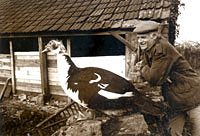
Keith passing the time of day with BD (Big Duck)
"We started with a drake and two ducks. After eight months we've had about 25 eggs to eat and 45 ducks of various sizes to eat."
Muscovy ducks can lay up to 195 eggs a year over a 40-week season. They'll nest three or four times during the season, hatching up to 20 ducklings a time. That leaves plenty of eggs for you, and LOTS of great meat!
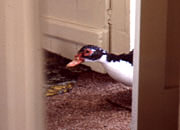 If you've never eaten Muscovy, you should know that it's really something. Muscovy is not at all greasy like other duck meat, it's more like extra-special veal, with a fine texture, very little fat, and a unique and delicious flavour. It's the finest duck there is, and maybe one of the finest of all meats.
If you've never eaten Muscovy, you should know that it's really something. Muscovy is not at all greasy like other duck meat, it's more like extra-special veal, with a fine texture, very little fat, and a unique and delicious flavour. It's the finest duck there is, and maybe one of the finest of all meats.
Muscovies are unique, the only domestic ducks that aren't derived from mallards. They come from South America and they're tree birds rather than water birds. So they don't need a pond to swim in (they do need water, but a large basin will do). And they fly. They're bigger and heavier than other ducks, and flying gives them large and powerful breast muscles, and strong, meaty legs. Muscovy breast looks like a fair-sized steak, you wouldn't guess it was duck.
For the producer they're cheap and troublefree: Muscovies more or less produce themselves. They're self-dependent, better foragers than other ducks, they grow fast and they seldom get sick. They clean up after your other livestock, eating what the others spill or leave.
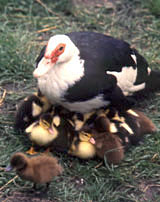
Muscovy ducks are good mothers -- the little brown ones are Khaki Campbells hatched by the Muscovy (Keith Addison)
They're personable and intelligent, great to have around, and they're quiet: they don't quack, the ducks chirp softly and the drakes hiss, and only when they have to -- they're not chatterers like geese, or showmen like roosters. Calm birds. And though they fly, they fly around, not away.
They come in black and white and various shades of grey and brown, with a bright red crest around their eyes and above the beak, like a cockscomb. Muscovies have never been industrialized or "developed", probably because they don't come in standard sizes: the drakes are much bigger than the ducks. A full-grown drake weighs about 15 pounds, and a duck up to 9-10 pounds.
Start with a drake and three ducks. Muscovy hens can set three or four times a year, with clutches of eight to 20 eggs. The eggs hatch after 35 days, the birds reach full size in 120 days, but can be slaughtered after 90 days.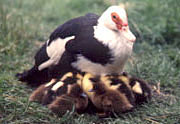 The meat yield is higher than any other duck, with 50% more breast meat, which is 98% lean, and the skin has 50% less fat than other ducks (but slaughtering a Muscovy will still yield a jar of fine duckfat for cooking).
The meat yield is higher than any other duck, with 50% more breast meat, which is 98% lean, and the skin has 50% less fat than other ducks (but slaughtering a Muscovy will still yield a jar of fine duckfat for cooking).
It's said Muscovies have less fat because they come from a hot climate and don't need the fat to keep warm. Strange, then, that in temperate winters they produce a warm waistcoat of fine down (a useful by-product). We've had Muscovies at temperatures dropping to -15 deg C, and they didn't mind at all. Hardy birds.
Muscovy Ducks -- Good information and an informative and entertaining write-up from the Domestic Waterfowl Club of Great Britain (yes, Muscovies do have a great sense of humour!):
http://www.domestic-waterfowl.co.uk/mozzie.htm
Muscovy Ducks -- ECHO Technical Note, from the Poultry Research Centre, Papua New Guinea. Some good general advice, excepting that ducklings do not need to be removed from the mother -- Muscovy ducks are excellent mothers. Even ducklings without mothers can be left to roam together outside with fair safety (no dogs or cats though). They're sensible little beasts, like their mums. They don't need much feeding, all Muscovies are good at foraging and fending for themselves. Muscovies don't need nearly as much care and management as this article implies.
http://www.echotech.org/mambo/images/DocMan/MuscovyD.PDF
Muscovy ducks -- Chapter 9 of "Microlivestock: Little-Known Small Animals with a Promising Economic Future", 1991, Board on Science and Technology. Read it online (free) or print it out at the National Academy Press:
http://books.nap.edu/books/030904295X/html/125.html
Home Grown Cooking from HGTV -- Muscovy Duck with Burgundy and Cranberry Sauce, serves two:
http://www.hgtv.com/hgtv/ah_recipes_sauce_dressing/
article/0,,HGTV_3194_1383740,00.html
Khaki Campbell ducks
Called Campbells because they were developed by Mrs Adele Campbell in Britain a hundred years ago, and they're khaki-colored, or darker, like cocoa, with green beaks, and the drakes have dark green heads and bronze backs and tails. Very cute ducks.
Adele mixed Indian Runner, Mallard, and Rouen ducks in search of an egg-laying machine, and succeeded admirably.
There are some breeds of chicken which might be able to outlay a Khaki Campbell, but they're probably highly specialized birds and might be more trouble than they're worth. Khaki Campbells are no trouble at all -- they're hardy, and good foragers. They'll lay 300 eggs a year or more -- up to 340. And they'll eat all the slugs and snails in your garden, and clear the pond of mosquitoes. Good backyard duck.
"Capable of sitting on and hatching its own eggs," says one reference -- no it's not! That's what Adele accomplished with them -- they don't get broody, and that's why they lay so many eggs. We only once saw a Khaki Campbell getting broody. She got agitated, quacked a lot, and fussed around in a thicket trying to make a nest, but after a few minutes she gave up and went for a swim instead, looking a bit puzzled and slightly embarrassed.
For more Khaki Campbells, put a few of the eggs under a nesting Muscovy. The Muscovy will hatch them, and look after the ducklings with her own. A chicken might do it too.
Indian Runners are also good egg-layers. Both types make good eating and meat production is good if you hatch the eggs under Muscovies.
You don't need a pond for ducks, but so much the better if you have one. Even a sunken bathtub will do, but make sure there's a shallow end so the ducklings can get out again, or they could drown. Don't let ducklings swim until they're a few days old.
Khaki Campbell Duck -- General information from the Poultry Breeds site at Oklahoma State University:
http://www.ansi.okstate.edu/poultry/ducks/khakicampbell/index.htm
Chickens
If you've only eaten industrial chickens up till now, then you really don't know what a chicken tastes like. A true free-range chicken from an organic smallholding or a backyard bird raised on scraps and scratchings is quite different -- you'll be amazed! And delighted.
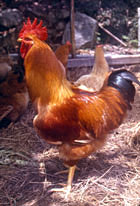
Rooster at Peaceful Garden, Lantau (Keith Addison)
Chickens are a must on farms of any size, and the ideal bird where space is limited. They scratch -- once, twice -- sharp eyes spot little bugs and tiny weed seeds, the beak darts down. Try to arrange it so that chickens get to work over your whole place every season, along with the ducks.
Chickens give you meat and eggs, they'll mix, shred and manure your compost materials for you, they're not much trouble , and they put themselves away at night. You don't need a rooster to have eggs, but you do need one if you want to breed them. Chickens cluck away busily and shriek if they're frightened.
Roosters are noisy -- don't believe it that they only crow at dawn! But you get used to it.
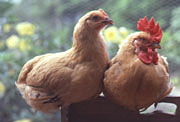
Chickens at Peaceful Garden, Lantau
Keep hens for laying, eat excess cockerels -- roosters fight, one is enough.
There are very many chicken breeds -- get what's most common in your area. Try for a good, all-round, general-purpose bird. Rhode Island Reds and Plymouth Rocks are general-purpose chickens. Leghorns are egg-layers, Cornish for meat. Bantams are conveniently small and good insect-catchers, and good setters too -- you can hatch other birds' eggs under a bantam.
Grazing arks -- good designs here:
Profitable Poultry Production by M. G. Kains, 1910
... and here (see Chapter 5. Poultry and Bees):
Handy Farm Devices and How to Make Them by Rolfe Cobleigh, 1910
Geese
 Strict vegetarians, ace lawnmowers, excellent watchdogs, intelligent, individualistic and opinionated, sociable, good conversationalists. Geese are great if you have the room: a fair-sized lawn or a small meadow, and a pond helps, but it's not essential. They're very little trouble, they can get most or all of their food from grazing and they help control weeds. One of the most efficient meat producers.
Strict vegetarians, ace lawnmowers, excellent watchdogs, intelligent, individualistic and opinionated, sociable, good conversationalists. Geese are great if you have the room: a fair-sized lawn or a small meadow, and a pond helps, but it's not essential. They're very little trouble, they can get most or all of their food from grazing and they help control weeds. One of the most efficient meat producers.
Feed them extra if you're breeding them. One goose egg is a meal for two. In their wild state, geese are one of the few creatures that mate for life. In domestic flocks they're more promiscuous, but the flock itself is a tightly-knit family unit, very clannish -- they don't approve of other birds
The first two eggs are infertile, take them away and cook them. You get more geese if you put the first lot of eggs to hatch under a broody Muscovy duck, then the goose will lay a second lot. Geese usually lay for 20 weeks in the year, from the spring. Chinese geese lay up to 100 eggs in a season.
Using Geese To Control Weeds -- Geese will not compact the soil as heavy machinery or people will. They will work seven days a week, rain or shine. They can be put into wet fields to work when machinery would bog down and cause severe damage to soil structure. Their agile necks allow them to pull weeds close to and from within the crop plants, where machine or hoe cannot. At the end of the season the grower can also process the geese for meat and feathers. All of this is accomplished while the geese are naturally spreading nitrogen-rich manure all over the field. -- 3,000-word article, Metzer Farms, California.
http://www.metzerfarms.com/weeder.htm
Weeding With Geese, by Glenn Geiger and Harold Biellier, Department of Animal Sciences, University of Missouri-Columbia -- Why do geese eat certain plants with relish while showing no interest whatsoever for others? Perhaps only a goose knows the answer. Proper use of geese can practically eliminate the need to hoe and pull grass and weeds. Expensive hand labor is replaced. The University of Tennessee Agricultural Experiment Station reports that using geese in cotton fields can save $35 or more per acre. 1,600-word article.
http://muextension.missouri.edu/xplor/agguides/poultry/g08922.htm
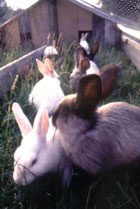
Rabbits in a grazing ark at Frogditch Farm, England, 1986 (Keith Addison)
Rabbits

Rabbits in a grazing ark at Frogditch Farm, England, 1986 (Keith Addison)
Rabbits breed like, well, like rabbits. They breed all year and the gestation period is only a month or less -- soon you'll have lots of rabbits. One buck to up to 10 does, but you have to keep them apart. You have to keep bucks apart too: rabbits fight. And they burrow under fences. Free-ranging is out, but grazing arks work well. Good meat production but not trouble-free. If you have children they'll do the work for you -- children love rabbits. Grass, hay, vegetable scraps.
Start with a buck and two does and you'll have rabbit meat all year round. For breeding, take the doe to the buck, or they'll probably fight. Leave them together for two days, then take her back again 12 days later. 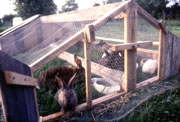 If she refuses to mate, then it worked the last time and she's pregnant. Leave her with her babies for six weeks, then mate her again two weeks later. In other words she'll breed four times a year.
If she refuses to mate, then it worked the last time and she's pregnant. Leave her with her babies for six weeks, then mate her again two weeks later. In other words she'll breed four times a year.
Rabbit manure is high-quality, easy to handle.
Guineafowl
Guinea fowl are an all-round asset on a smallholding. The only downer is the weird and noisy noise they make -- and even that's an asset, because they're better watchdogs than watchdogs are (as good as geese). And you get used to the row. Guineafowl need very little care -- just leave them alone, they do what they like, feed themselves, look after themselves, and lay about the best eggs going. Smallish but rich and delicious! -- as they should be, nurtured on a rich and varied diet of insects and weed seeds. They effectively keep the pests down. Guinea fowl are THE best control for ticks.
Guinea Fowl for Tick Control -- "The second year we were here, we purchased a few guinea fowl. Ticks have been very rare in our life since then." Good basic tips on free-range guinea fowl.
http://www.countrysidemag.com/issues/3_1998.htm#Tick%20Control
General tips
Spreading wood ash on the floor of the chicken coop under the roosts is a good way of dealing with the droppings. The chicken manure and the wood ash react, driving off the nitrogen and drying out the manure, producing an easily handled, easy-to-store, organic fertilizer rich in potassium and phosphorus. (Like all "fertilizers", you get the best effect by adding it to the compost pile rather than the soil.)
Spread the type of "browns" you use for composting in the chicken run -- dead leaves, spoiled hay, straw, sawdust, shredded newspaper and cardboard, wood chips. Throw edible scraps from the vegetable garden and the kitchen on top. The chickens will scratch it up, manure it, and mix it thoroughly for you -- when it's ready, put it straight in the compost bin.
Vermicomposting -- with red worms -- makes extra sense if you have poultry. Worms are high protein (better than beef) and make excellent live (or dried) poultry feed. Worm populations double at least in six weeks, and they eat their weight of compost material a day. It's not hard to figure it so that you get a good supply of excess worms for your poultry. See Vermicomposting.
See "Friend Earthworm: Practical Application of a Lifetime Study of Habits of the Most Important Animal in the World" by George Sheffield Oliver, 1941. Dr Oliver was one of the first to harness the earthworm to the needs of the farmer and gardener, making highly fertile topsoil for optimum crop growth, and producing a constant supply of cheap, high-grade, live protein to feed poultry. He devised simple yet elegant and effective systems to bring costs and labour down and productivity up to help struggling farmers make ends meet. Full text online at the Journey to Forever Small Farms Library.
High-protein poultry feed from thin air
Lots of flies around? Collect some kitchen slops -- cooking water and juices and leftovers from meat and fish dishes, some milk: anything that will go really putrid if you leave it for awhile. Then leave it for awhile. When it stinks really badly, gather some compost materials, say 4-5 cubic feet, spread it out in the sun, and sprinkle it with the putrid kitchen liquids. Don't get it too wet -- slightly more wet than compost should be.
In no time it'll be buzzing with flies. Leave it until you're quite sure lots of flies have had ample opportunity to lay their fill of eggs. Then scoop it all up, put it in a double garbage bag (one inside the other), put the bag in a suitably sized cardboard box, and close the bag lightly. It will soon stop smelling. Check it every day.
After a week or so, you'll open it to find the surface flat, finely divided, and writhing slightly, or even considerably, with maggots, lots and lots of maggots. Now's the time, don't leave them to turn into flies. Two options:
Option 1
Sift it with a circular gardener's sieve with a 3/16" mesh (stainless steel mesh is best). This will leave you with a pile of nice black compost and a sieve full of maggots -- first-class poultry feed. Your chickens, ducks, guinea fowl will think it's Christmas. The geese, who're strict vegetarians, will be appalled and disgusted by the whole thing, but never mind. Add the siftings to the compost bin or the worm bin. Maggots, by the way, assist rather than hinder the composting process. And, disgusting as they may look, fly maggots do not spread disease.
Option 2
Let the birds do the sifting for you -- but don't throw it onto their bedding or the mulch in their run because they'll miss a few maggots, leaving them to hatch into flies. On bare ground, they'll definitely get them all.
You've just wiped out a generation of flies.
Instead of using liquids, you can let a couple of litres of kitchen scraps get thoroughly putrid in a bucket with a lid on it and use that instead.
See The Housefly by Professor Roy Hartenstein, online at the Journey to Forever Small Farms Library.
Putting the Bluebottle Fly to Work -- from "Friend Earthworm: Practical Application of a Lifetime Study of Habits of the Most Important Animal in the World" by George Sheffield Oliver, 1941, online at the Journey to Forever Small Farms Library.
Poultry as unpaid labour
If you keep Muscovy ducks (you should!) there might not be enough flies around to make a boxful of maggots for you.
A Canadian study of fly controls with dairy calves found that Muscovies caught 30 times more houseflies than commercial flytraps, baits or flypaper. The ducks also ate spilled feed so flies couldn't breed in it.
The Heifer Project Exchange quotes a development worker in Togo in Africa reporting that the local people were not bothered by flies because their Muscovy ducks killed them all. They slaughtered some ducks, opened the crops to see what they'd eaten, and each one was filled with hundreds of flies. (ECHO)
Slugs and snails eating your salad greens? Old country lore says: "There is no such thing as a surfeit of slugs, merely a dearth of ducks."
Particularly Khaki Campbell ducks, also Indian runners, though all ducks are ace slug catchers, they'll even go after their eggs in the soil. The ducks, though, might also appreciate your salad greens, so you'll have to watch them.
They're not pets
You can get very fond of these birds. Distinguish at an early stage between birds for breeding and birds for eating: you can give the breeders names, but DON'T name the meat birds, and don't let them charm you too much. Keep it in mind what fate you have in store for them!
Children can accept this as long as you're completely honest and forthright about it right from the start. Don't euphemize.
If you don't eat them they'll breed you out of house and home. If you can't stand the thought of killing them, then don't let them breed, just take all the eggs. Or get someone else to do it for you. You can learn slaughtering from a book, though it's better to get someone to show you.
Doing it
-- "Do you know how to kill a chicken?" Granny Choi asked. "Of course I do," Keith replied. "You take it by the head and chop its body off."
Decapitation is probably the best way, especially for beginners. Cutting their throats works well, and is probably just as instant. Reflex flapping makes both these ways messy. The non-messy way is to wring (break) their necks, but it takes practise to get it right and it's rough on the birds while you climb your learning curve. Maybe you know someone who can show you how.
Kill birds well away from the rest of the flock, take them away one at time -- don't make them wait in line for what they know is going to happen.
Head
Use a cleaver, the heavier the better, and keep it sharp. Use a big, heavy piece of timber as a chopping block. Hammer a nail into it near one end. Tie a short length of thin rope to the nail and put a noose in the other end. Lay the bird down on its back on the block, put the noose round its neck and tighten it -- not too tight. Hold the bird by the legs and pull it away from the nail so it can't move but isn't stretched. If you stroke its chest a bit and make gentle, reassuring noises it'll relax and probably close its eyes. Now's your chance. It needs a single, swift, well-aimed and decisive blow. Keep hold of the legs, hold the bird away from you until the reflex flapping stops.
Throat
Use a sharp knife with a longish blade (not serrated). Take the bird by the feet and let it hang upside down for awhile. It will soon calm down and relax. Then hang it from a pole or rail about 6ft from the ground. Tie a thin rope to the rail and loop it a few times round the bird's feet. You can secure it with a short stick tied to the rope, tuck the stick between the legs. Take the head firmly but gently in one hand and cut across the throat about an inch below the head with a single, strong, sweeping cut. Step back and wait for it to stop flapping.
Plucking
Dip the carcase in hot water to loosen the feathers -- not too hot or you'll scald it and the skin will tear. If there's down, pluck the bird on a table and collect the down with a vacuum cleaner. Compost the feathers. Offal to the compost bin or the pig. Another option is to skin the bird, feathers and all.
See also:
Processing Poultry at Home, Texas A&M University -- 12-page illustrated step-by-step guide, facilities and equipment, New York dressing, evisceration, chilling and packing, skinning. Download PDF:
http://gallus.tamu.edu/Extension%20publications/b-1383.pdf
Home Processing of Poultry, Melvin L. Hamre, University of Minnesota Extension — Illustrated olnline guide: selecting birds for slaughter, processing facilities and equipment, killing and dressing, evisceration, chilling and packing, splitting broilers or fryers, cutting up whole carcasses
http://www.extension.umn.edu/distribution/livestocksystems/DI0701.html
See Poultry resources
See also:
Pasture
Pigs for small farms
Farming with animals
Small farms
Small farm resources
Community-supported farms
Farming with trees
Farming with animals
Pasture
Pigs for small farms
Poultry for small farms
Aquaculture for small farms
Composting for small farms
Controlling weeds and pests
Small farms library
City farms
Organic gardening
Building a square foot garden
Plant spacing guides
No ground? Use containers
When to sow what
Seeds
Garden pond
Gardening resources
Composting
Making compost
Composting resources
Composting indoors
Vermicomposting
Humanure
Composting for small farms